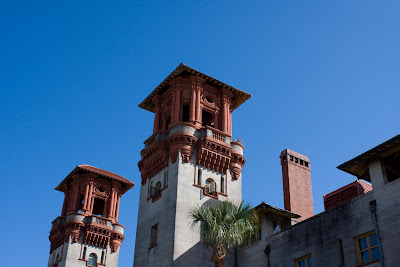Fernandina Beach, FL 30º40.229N | 81º28.172W
 |
| Jessie Marie sneaking up on us. Photo by Chip |
The flock is heading south again. After a short respite -- and a beautiful weather window -- in St. Mary's, we're all migrating, hoping to shake off cold weather for good.
We left the mooring field in Fernandina at 7:30 with our friends on
Kajon after much deliberation about what the weather might hold, finally deciding whatever it was, we would manage. Our goal was to make the 62-mile trudge to St. Augustine, a long slog, to a harbor we didn't want to enter after dark.
The weather was kind if cold, and the water delivered friendly faces along the way.
"
Cara Mia, Cara Mia, this is
Jessie Marie."
"Where are you?" Chip asked.
"Right behind you!"
Sure enough, there they were, our Nova Scotian friends Karen and Dale, tailing us, although not for long. A bridge in Sisters Creek that opens on request bunched five of us sailboats together just as we were about to enter the St. John's River.
 |
| Photo by Chip |
Jessie Marie came flying around us looking fabulous, just as I was saying, "Hey, there's a lot of current here and the GPS isn't showing me the route." Two things that together were making me a little nervous, since I was at the helm. At this point we were the last of the five boats, all close together, following this pink line:
I was about to pass a very tiny sailboat in front of me as we approached the pink arrow. Looking ahead to the first boat in the group, I did a double, triple, quaruple take. The first boat suddenly started skittering sideways off to starboard -- fast. Behind it,
Kajon took off like someone plopped it on a conveyor belt, shooting them way off to the right as
Jessie Marie came up behind them.
The current was barreling, practically roaring around that point of land by the arrow, and slamming the boats sideways as we were entering the mouth of Pablo Creek.
I realized at this point (clever me) that in a few minutes, I would be thrown on the conveyor belt -- and I had a small sailboat to my right, exactly where the conveyor belt would take me. My fear was that I would block the current for them meaning I would fly to the right, they would not, and, well, you get the idea.
I threw the throttle in neutral and then in reverse, trying to slow down enough to let the small boat clear my bow before I hit the current -- and them. Reverse, reverse, throttling up, up, up.
Chip tried to hail the small boat on 16, "Get going, get going!"
Cara Mia worked with me beautifully. We slowed enough to let the other boat get just ahead, and, since our forward motion had slowed and our boat is heavy, we didn't get thrown as far to starboard as the others. I also had the benefit of knowing what was coming and held to port as we entered the current.
Whew.
 |
| Debi on Kajon snapped this pic just as we were entering the roar. |
The rest of the day passed with less drama. As we neared St. Augustine, we passed our British friends, Barney and Di, on
Sea Gal, sailing as big as you please, just as if they were on the high seas. I swear they were sipping tea out of dainty China cups in the cockpit.
 |
| Sea Gal. photo by Chip |
Inspired, we unfurled the jib and practically flew into St. Augustine at 8.5 knots, entering the harbor at St. Augustine at dusk. We took a wrong turn, then a U-turn, then had to wait for the 4:30 opening of the Bridge of Lions -- and then had to wait for the boats coming through with the current (right of way). But after 9 1/2 hours on the water, we picked up our second mooring ball, not quite as professionally, and settled, exhausted, resting on the knowledge that we were staying in St. Augustine for a whole week on the peace of a mooring ball.
Peaceful like in Fernandina? We'll see.
St. Augustine, FL 29º53.153N | 81º18.319W
 |
Freedom wings through the Bridge of Lions...
|
 |
| ...followed by their mateys on the Black Raven. |



































































